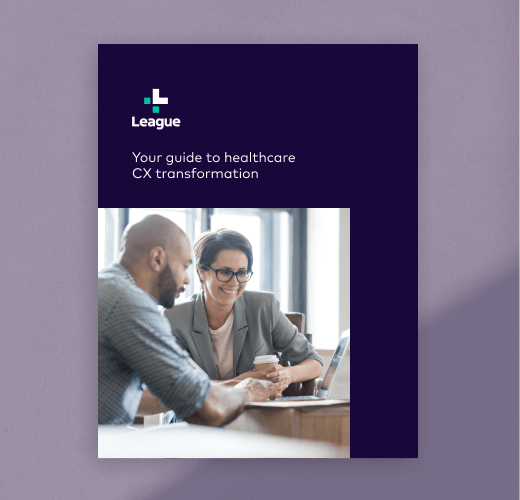Summary
- IT teams play a crucial role in enabling healthcare CX transformation by creating data lakes, leveraging AI/ML, and ensuring secure, integrated experiences.
- Partnering with a digital health platform company accelerates implementation and ensures interoperability with existing infrastructure.
- Healthcare organizations must prioritize CX transformation to remain competitive amidst evolving consumer expectations and new market entrants.
Consumer experience (CX) was once a term traditionally associated with an organization’s marketing efforts. The rise of omnichannel healthcare experiences, however, means IT strategies play an integral role in CX transformation as well. With the right infrastructure and partnerships, IT teams can enable a next-generation CX that delivers meaningful results—such as improved consumer satisfaction, retention and health outcomes.
Here’s how technology teams can support their organizations’ CX initiatives:
Create a data lake
Healthcare data is siloed by disjointed products and systems. The lack of communication between these systems negatively affects consumers and organizations. It leads to fragmented healthcare experiences as well as administrative burdens, retention problems and a low return on technology investments for organizations. To free siloed data and streamline care and processes, technology teams should be focused on creating a data lake.
A data lake integrates all of an organization’s data sources—as well as third-party data—into a single database. One McKinsey study shows “comprehensive, connected and dynamic customer-level datasets allow the organization to map and track customer behavior across interactions, transactions and operations¹.” With a more complete, real-time view of patients and members, organizations can unlock opportunities to deeply personalize experiences.
Leverage artificial intelligence (AI) and machine learning (ML)
When paired with a healthcare data lake, AI and ML enable integrated insights that guide personalized patient and member journeys. The personalization aspect of the healthcare CX is significant, as this is what drives engagement. Research shows people who are more engaged in their healthcare are more proactive about their care², while less engaged people are three times more likely to have unmet medical needs and two times as likely to delay getting care³.
By leveraging AI and ML, organizations can better understand their consumers and recommend next best actions to engage them in their health journeys. Organizations can deliver general health or condition-specific content and recommendations to consumers—all based on their unique medical histories and health information. These targeted next best actions drive usage because of their deep personalization.
“You have to have the right kind of analytic capabilities to be able to leverage data the right way.”
TRACY SAULA
SVP Product and Health Experience, Highmark Health
The use of predictive analytics and personalization helps close gaps in care by guiding consumers to the right care, resource or content at the right time. This improves health outcomes, which leads to lower healthcare costs for payers and increased patient satisfaction and retention for providers.
Enable secure, integrated experiences
A best-in-class CX requires cohesion across an organization’s ecosystem, which means all systems, data sources and point solutions need to be integrated into one platform. When products are no longer siloed, consumers can freely move through their individual journeys at their own paces and engage with the healthcare ecosystem through a broad spectrum of touchpoints.
“Creating new healthcare customer experiences requires a new approach to technology and how we connect the experiences together.”
LAURA WESTERCAMP
Managing Director Life Sciences, Accenture
Consumers are ready to use technology to manage their health—as long as it is secure and provides them with valuable health insights. In one Accenture study, 32% of respondents said they would use digital technology if it provided better information about their health, and 29% of respondents said they would use the technology if they had more confidence in data privacy⁴. To ensure security and build trust, a healthcare organization’s CX must adhere to healthcare standards and regulations and have rigorous processes for evaluating the strategies of third-party vendors.

Accelerate time to market through partnership
Time to market is crucial during CX transformation, however, a lack of resources can make it difficult for technology teams to move quickly. To accelerate innovation, technology teams can work with a CX transformation partner.
A CX transformation partner can provide the technological infrastructure a healthcare organization needs to build a custom CX platform. A partner, such as League, with an open-architecture, extensible and configurable platform helps organizations get to market quickly with a differentiated platform and service offerings that are truly modular and interoperable.
League’s platform is built around Fast Healthcare Interoperability Resources (FHIR) standards that leverage the Google Cloud Platform (GCP) Healthcare Application Program Interface (API). Combining an organization’s dataset with our FHIR-based orchestration engine and AI and ML capabilities, we enable experiences that deliver personalized next best actions for patients and members. These data-driven experiences encourage usage, leading to better health outcomes and improved consumer satisfaction and retention. Moreover, our technology can be embedded in existing platforms or deployed in net-new platforms within six months.
Begin transforming the CX
To deliver best-in-class patient and member experiences, organizations must have the right technology and infrastructure. IT teams need one platform that spans the organization’s systems and processes, monitors quality and security and enables cohesive experiences. If healthcare organizations haven’t already begun the transition to the platform-based CX, the time to execute is now. New healthcare market entrants bring digital-first expertise and know superior experiences drive consumer engagement and loyalty.
¹Source: Prediction: The Future of CX; Rachel Diebner, David Malfara, Kevin Neher, Mike Thompson and Maxence Vancauwenberghe; McKinsey Quarterly, 24 February 2021
²⁻³Source: Judith H. Hibbard and Jessica Greene; What the Evidence Shows About Patient Activation: Better Health Outcomes And Care Experiences; Fewer Data on Costs; Health Affairs, Volume 32, No. 2 (2013): 207-214
⁴Source: The Ultimate Health Experience: What People Want; 2021 Accenture Health and Life Sciences Experience Survey

